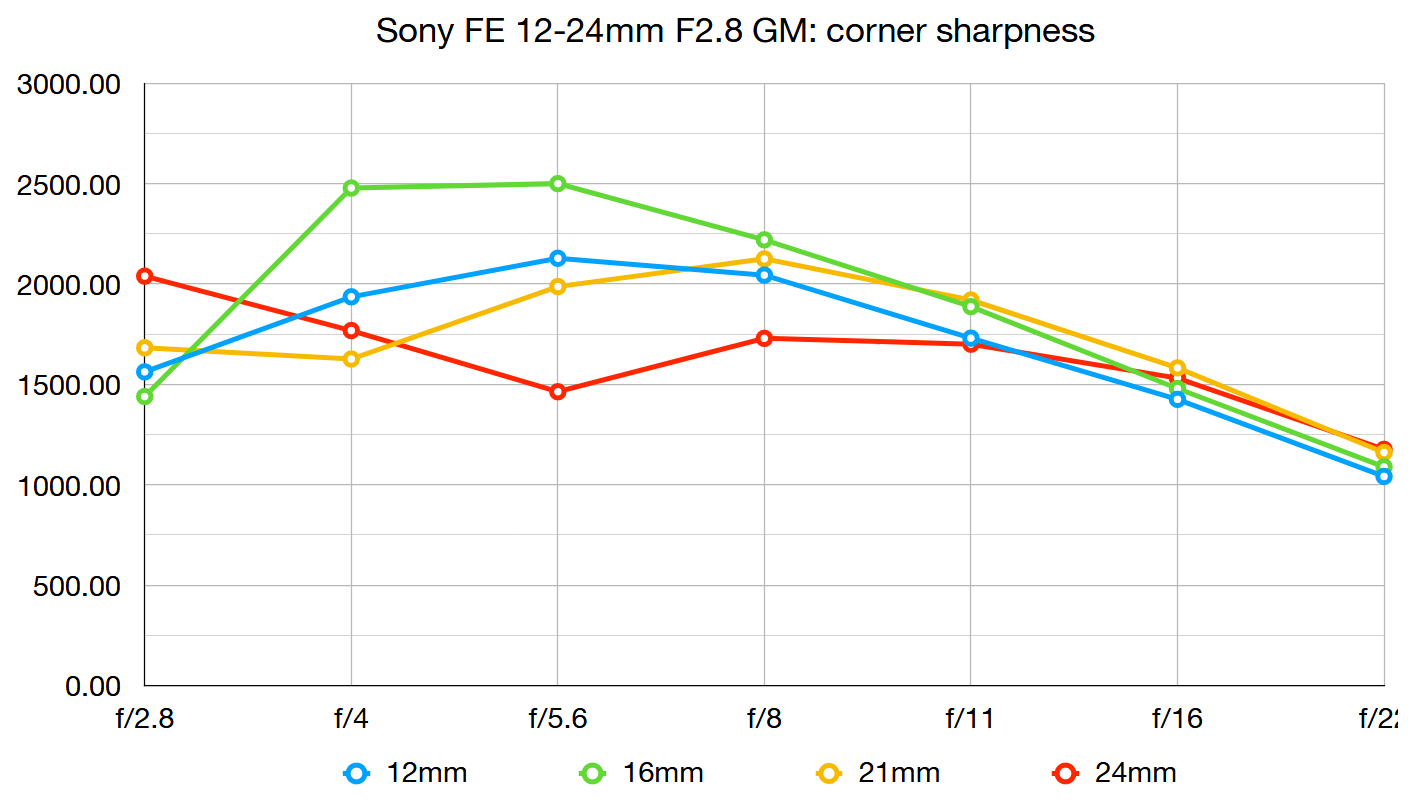Digital Camera World Verdict
Following warm on the heels of Sony’s FE 12-24mm f/4 G zoom, which was launched three years ago, the new G Master edition delivers the same ultra-wide viewing angles but goes an f/stop wider in aperture. By necessity, the front optical elements are considerably larger but the lens is reasonably lightweight and easily manageable. It certainly goes large in terms of performance, with outstanding image quality and rapid autofocus, making it well worth the typically high asking price for a G Master lens.
Pros
- +
Impressive image quality
- +
Impeccable handling
- +
Ultra-wide maximum viewing angle
Cons
- -
As usual, the hood isn’t removable
- -
Expensive to buy
Why you can trust Digital Camera World
Until now, the FE 12-24mm f/4 G has been Sony’s most wide-angle zoom and, like the competing Sigma 12-14mm Art lens for DSLRs, it has a constant-aperture f/4 rating. Stepping up to premium G Master optics, the widest f/2.8 ‘trinity’ zoom was the FE 16-35mm f/2.8, which is another fine lens but relatively lacking in maximum viewing angle, at 107 degrees. The new Sony FE 12-24mm f/2.8 G Master boosts diagonal coverage back up to an incredible 122 degrees, which is wider than the human field of vision, while also retaining a fast and constant f/2.8 aperture. This combination makes it the world’s fastest lens in its class.
Specifications
Model number: SEL1224GM
Mount: Sony E (full-frame)
Full frame: Yes
Autofocus: Yes
Image stabilization: No
Lens construction: 17 elements in 14 groups
Angle of view: 122-84 degrees
Diaphragm blades: 9
Minimum aperture: f/22
Minimum focusing distance: 0.28m
Maximum magnification ratio: 0.14x
Filter size: N/A
Dimensions: 98x137mm
Weight: 847g
Key features
The extreme viewing angles of this lens make it a top tool for everything from cramped architectural interiors to sweeping landscapes and the night sky beyond. The fast aperture is a particular bonus for freezing movement under low lighting conditions and is essential for astrophotography. But this lens certainly isn’t a case of ‘never mind the quality, feel the width’, as it has a particularly impressive feature list.
Starting with the all-important optical design, there are no less than three XA (eXtreme Aspherical) elements. These call for the most advanced manufacturing techniques, to ensure that surface precision is kept to a tolerance of just one hundredth of a micron. Indeed, the large front element is an XA type, representing a significant manufacturing challenge. The aim is for optimised resolution and super-smooth bokeh. The latter might seem superfluous in such a wide-angle lens but, thanks to a short minimum focus distance, you can actually get quite a tight depth of field at f/2.8, in the longer sector of the zoom range.
Further optical highlights include an additional aspherical element, three ED (Extra-low Dispersion) elements and two Super ED elements. Again, a necessity of the ultra-wide viewing angles and large aperture is that the front elements are both large and deeply curved, which runs the risk of excessive ghosting. A new Nano AR Coating II has been designed to keep these unwanted attributes to a minimum, especially when shooting at short zoom settings, where the front element extends and nears the forward end of the integrated petal shaped hood.
Lenses with large and heavy elements often have sluggish autofocus speeds. Again, Sony has tackled the problem head-on, employing four high-speed XD (eXtreme Dynamic) Linear Motors, two for each of the pair of groups that move during focusing. This makes for super-fast autofocus, ideal for tracking moving subjects in action sports, even at very close range.

Build and handling
Build quality is up to Sony’s usual G Master standards, with a particularly robust, weather-resistant construction. A fluorine coating is applied to the front element, to repel moisture and grease and to aid easy cleaning. As in virtually all ultra-wide-angle prime and zoom lenses, the hood is an integral part of the design, to protect the protruding front element. As such, there’s no filter attachment thread, but a rear filter holder enables the use of gel filters, and the lens comes complete with a cutting template.
The best camera deals, reviews, product advice, and unmissable photography news, direct to your inbox!
Considering the zoom range and aperture rating, the lens is fairly compact and lightweight. For example, the Sigma 12-24mm f/4 Art lens for DSLRs weighs in at 1,150g but the Sony is a mere 847g despite being an f/stop faster. Handling refinements include a focus hold button, which you can assign to alternative functions through the host camera’s menu system.
The zoom and focus rings operate with smooth precision. For the latter, the ring is electronically coupled to the Linear Motors. This doesn’t always feel entirely natural but, in this case, manual focusing is very responsive and precise. Manual override of autofocus is available, and there’s also an AF/MF switch on the lens barrel.
Performance
Living up to Sony’s claims, autofocus is very fast, virtually silent and highly accurate. Sharpness is mostly fabulous, even out to the extreme corners of the image frame, which is no mean feat for such an ultra-wide-angle lens. In real-world shooting, the only exception to this that we found was at the long end of the zoom range, where we had to stop down to f/4 for excellent centre-sharpness, and to f/5.6 for great corner-sharpness.
Especially towards the long end of the zoom range, the f/2.8 aperture enables a fairly tight depth of field at close focus distances, and the quality of bokeh is very soft and smooth. At the short end, vignetting at f/2.8 and barrel distortion can be noticeable but automatic in-camera corrections are available for this as well as for the very minimal amount of colour fringing.
Resistance to ghosting and flare is outstanding for such a wide-angle lens, the optical design and uprated nano-structure coatings really earning their keep. All in all, it’s a really top-performance zoom.
Lab data
We run a range of lab tests under controlled conditions, using the Imatest Master testing suite. Photos of test charts are taken across the range of apertures and zooms (where available), then analyzed for sharpness, distortion and chromatic aberrations.
We use Imatest SFR (spatial frequency response) charts and analysis software to plot lens resolution at the centre of the image frame, corners and mid-point distances, across the range of aperture settings and, with zoom lenses, at four different focal lengths. The tests also measure distortion and color fringing (chromatic aberration).
Sharpness
Centre-sharpness is outstanding, even when shooting wide-open at f/2.8, throughout the entire zoom range. Sharpness towards the edges and corners is also excellent, especially for such an ultra-wide-angle zoom.
Fringing
Lateral chromatic aberration is entirely negligible at all zoom and aperture settings, even at the extreme corners of the image frame.
Distortion
It’s no surprise that barrel distortion is noticeable at the 12mm end of the zoom range, although in-camera corrections can take care of this. From 16mm to 24mm distortions are minimal.
Verdict
There’s no denying this new G Master lens is a pricey purchase but you certainly get what you pay for. The no-compromise optical design delivers supreme image quality, the autofocus system is rapid, smooth and virtually silent, handling is excellent and build quality is superb. Edge-to-edge sharpness is outstanding even at the very shortest focal length, while resistance to ghosting and flare is amazing. All in all, it’s a fabulous lens.
Read more:
The best Sony lenses: top lenses for Sony mirrorless cameras
The best Sony camera: from Cyber-shots to Sony Alphas
Matthew Richards is a photographer and journalist who has spent years using and reviewing all manner of photo gear. He is Digital Camera World's principal lens reviewer – and has tested more primes and zooms than most people have had hot dinners!
His expertise with equipment doesn’t end there, though. He is also an encyclopedia when it comes to all manner of cameras, camera holsters and bags, flashguns, tripods and heads, printers, papers and inks, and just about anything imaging-related.
In an earlier life he was a broadcast engineer at the BBC, as well as a former editor of PC Guide.













